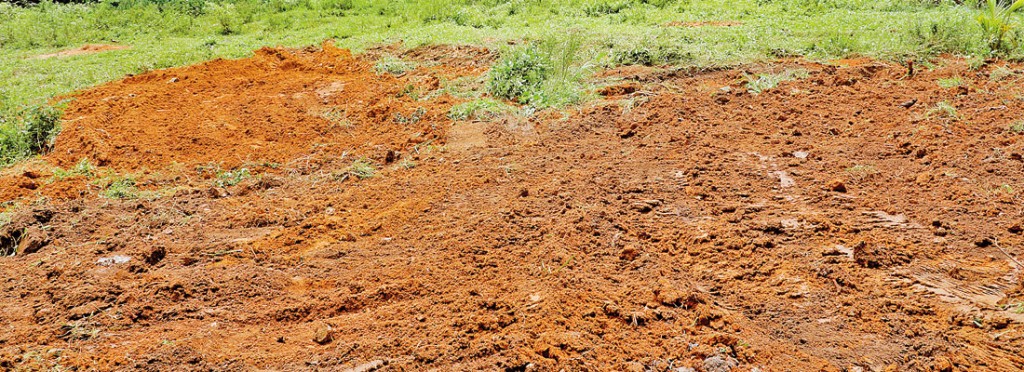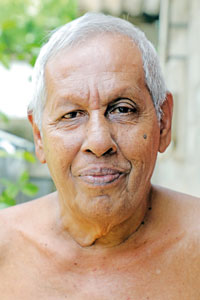News
Cadavers used in medical studies dumped recklessly
View(s):By Nadia Fazlulhaq Pix by M. A. Pushpa Kumara
Residents around the Joranis Peiris cemetery in Pannipitiya have been horrified to find parts of human remains in their area.
“Some people were able to video record workers from a leading funeral director in Maharagama throwing bodies used by the medical students of Sri Jayawardenepura University. Monitor lizards were seen digging up bodies at night and during the day, crows, and street dogs were seen scavenging on human body parts. There are so many open wells here,” said resident
K. Thilakaratne.
Another resident who wished to remain anonymous said he saw a deceased person’s finger while others have felt disgust about more human body parts scattered in the area.

Joranis Peiris cemetery: Freshly covered up body parts that had been dumped in an undignified manner. Pic by M.A. Pushpa Kumara
Following this incident, authorities were quick to react. The governor of the Western province requested families and individuals to not change their minds on donating bodies of their loved ones to medical faculties.
“The video footage showed how bodies donated for medical education were handled with no respect. We have to find a way to dispose of bodies in a dignified manner. Immediate action was taken to prevent any incident like this in the future. At an emergency meeting this week it was decided to cremate the dissected bodies instead of burial and the cost will be borne by the Maharagama Urban Council. If funds are insufficient the state will assist the UC. Meanwhile, action will be taken against the funeral director,” Governor Roshan Goonetileke told the Sunday Times.
Maharagama Urban Council’s Secretary Anura D. Dias said in this incident workers had dumped the bodies in a different pit and not into the assigned one.

K. Thilakaratne
“The pit was for placing ashes. Instead of placing the bodies they have thrown the bodies, resulting in dissected parts being scattered,” he said.
For nearly three decades, bodies were buried at the Godigamuwa cemetery, but recently, the Peiris cemetery has been designated.
“We cannot allocate the Godigamuwa cemetery, Maharagama for burial due to the space issue. These pits should be large, about 20 feet deep and cannot be fully sealed as they need to be opened again. There are several crematoriums coming under the urban council. We will plan out the cremations accordingly,” he said.
The Sunday Times learns that the university pays Rs. 1,000 per body to the funeral home to arrange transport and burial.
“Since 1994 we have been paid a meagre amount and it has not changed for many years. We have been asking the urban council to allocate the public cemetery in Weli-Para, Thalawathugoda which has more space for burial,” said S. Brito, proprietor of Rohini Funeral Directors.
He said until recently, bodies were buried in Godigamuwa cemetery where the lorry carrying bodies could easily reach the burial pit. However, he said, in the Peiris cemetery, the lorry could not reach the pit and bodies had to be carried several feet.
“The workers not only had to carry the bodies, but had to remove polythene sheets and place the bodies in the pit. We have asked them to release the bodies in coffins which is easier for us,” he said.
Prof. Aloka Pathirana, dean of the university’s faculty of medical sciences said there is concern about the way cadavers used by the anatomy department are handled at the cemetery.
“Bodies used for cadaveric dissection have been buried since 1994 and this is the first time such an issue has occurred. The public should not witness dissected bodies used for medical studies. Unfortunately the university cannot afford to provide coffins and cremations. About 18 bodies are released twice a year,” he said, adding that the two staff members who were present at the burial had vouched that the disposal was done correctly.
Dr. Varuni Tennakoon, head of the university’s anatomy department said one body is usually dissected for one-and-a-half years and bodies are buried under the supervision of two non-academic staff.
“The polythene that the body is wrapped in is removed during burial due to decomposing issues. This week we decided to wrap the bodies in dark coloured cloth pieces as coffins are too costly for us,” she said.
She said dissection is the only effective way of teaching anatomy in medical schools.
“Public not donating will negatively affect the quality of medical education. We ensure that respect is maintained at dissection halls and an annual pirith ceremony is held to invoke blessings for the deceased with relatives of the last 100 donors invited,” she said.
The best way to say that you found the home of your dreams is by finding it on Hitad.lk. We have listings for apartments for sale or rent in Sri Lanka, no matter what locale you're looking for! Whether you live in Colombo, Galle, Kandy, Matara, Jaffna and more - we've got them all!

